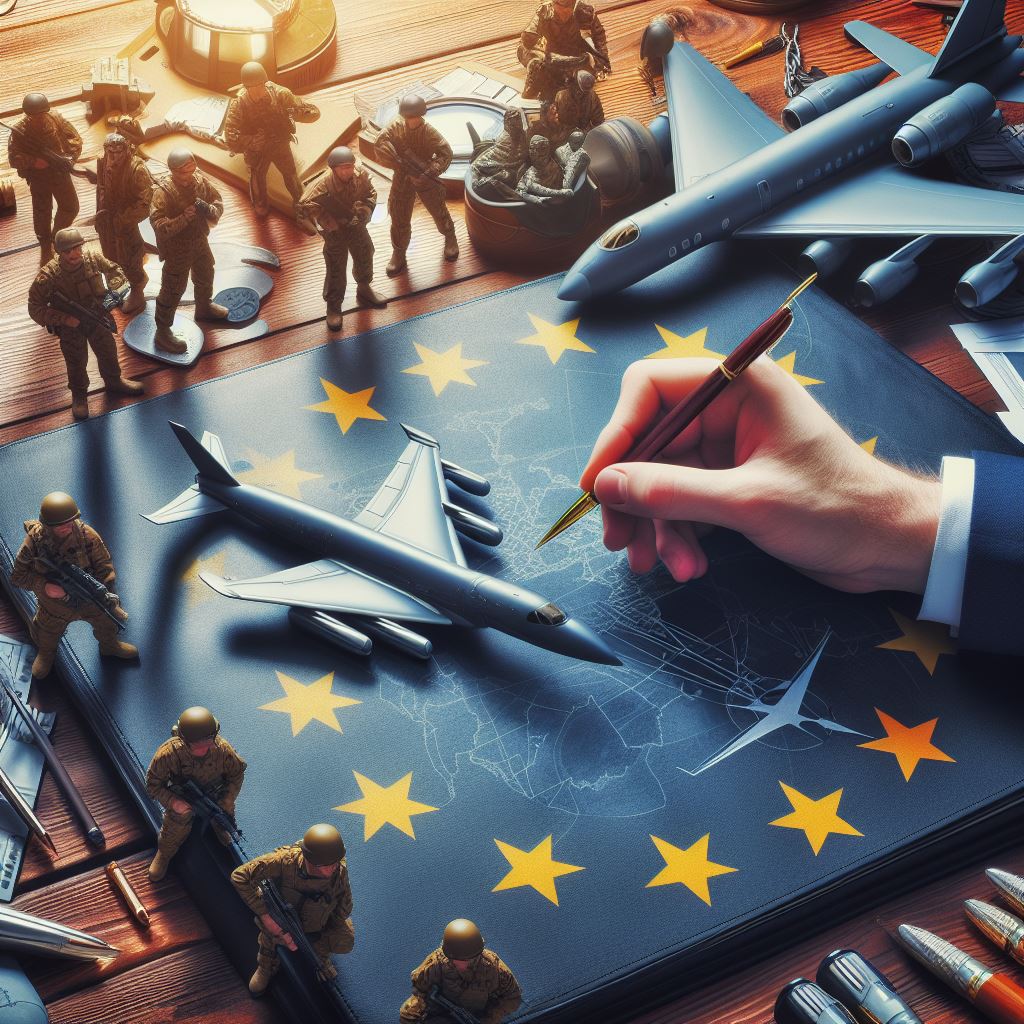- With the war in Ukraine and Trump’s possible new mandate, the European Union concluded that an effective defense response is necessary;
- The current shortage of military resources highlights the need for military build-up in Europe;
- European executive leader Ursula von der Leyen presented the European Union’s first Defense Industrial Strategy to prepare Europe for a more competitive world.
In an era of increasing uncertainty and geopolitical challenges, Europe finds itself facing a critical crossroads: the need to reinforce its defense capacity in the face of potential Russian aggression. With the shadow of war in Ukraine and the possibility of a new Trump presidency in the United States, the pressure for an effective response is undeniable.
The lack of ammunition and equipment among European countries, highlighted by the Ukrainian conflict, requires an urgent call to action. Therefore, the European Commission (the bloc’s executive arm) presented the European Union’s first Defense Industrial Strategy, outlining a path towards the military preparation necessary to face the challenges of this century.

Why does Europe need to increase its defense capacity?
Europe has been facing growing pressure to enhance its defense capability, especially in light of the war between Russia and Ukraine and the possible reelection of Trump to the presidency of the United States.
The war in Ukraine and the shortage of ammunition and equipment among European countries to send to Kiev, with the exception of Poland, have underscored the urgency of measures to strengthen military readiness in the region. European Commission President Ursula von der Leyen revealed in March 2024 the first European Union (EU) Industrial Defense Strategy in response to these challenges.
Today, there are significant gaps in Europe’s defense capacity. This has occurred due to years of low defense investment following the end of the Cold War. This period of relative peace led many countries to spend less than the 2% of GDP determined by NATO. Consequently, the region lacks essential supplies such as ammunition, artillery pieces, armored vehicles, and intelligence, surveillance, and reconnaissance resources.
Economists and defense planners have long advocated for greater cooperation between European governments and defense companies to address these deficiencies.
If European countries work together in defense, they can save a lot on their military equipment investments. They could avoid producing and buying unnecessary identical military equipment, instead producing more collectively and paying less.
However, making this happen is difficult because each country prioritizes its own interests, sometimes seeking to protect its own industries or because they do not always work efficiently together due to a lack of standardization among European military forces.
Regarding the duplicated production and purchase of military equipment, one can use as an example Main Battle Tanks, which have 6 different models produced in Europe; or Infantry Fighting Vehicles, which have 11 different models produced in the bloc; or Destroyers and Frigates, which have an incredible 26 different models produced on the European continent.
This diversity of models highlights the need for greater military integration in Europe to reduce internal competition for buyers and operators, as well as to promote a more efficient and coordinated approach to the production and use of armaments.
In addition to duplicated production, it is important to note some examples that have demonstrated a lack of military integration in the EU:
- During the 2015 migration crisis, EU efforts to coordinate naval operations in the Mediterranean were hindered by a lack of standardization among the navies of member states, making search and rescue operations less efficient.
- The Airbus-led A400M military transport aircraft project faced delays and excessive costs due to disputes among NATO member countries over the division of additional financial costs and development responsibilities.
- Despite European countries being concerned about cyber attacks, the European Union is not working unitedly to protect itself. Countries are unwilling to share sensitive information and do not reach an agreement on how to deal with potential cyber attacks, hindering defense against these threats.
Therefore, the European Union is seeking to expand its participation in defense industrial policy, contributing to European defense readiness. Meanwhile, NATO continues to play a key role in the collective defense of European countries.
However, with the potential election of Donald Trump in the US and his disdain for NATO, European countries may find themselves alone in defending the continent in case of aggression. That is, Trump’s US may not honor Article 5 of the NATO mutual defense pact.
Article 5 of the North Atlantic Treaty, which is the founding document of the alliance, establishes the principle of collective defense, stating that an armed attack against one or more NATO members is considered an attack against all members of the organization. This means that all members must consider an attack on one of them as an attack on themselves and respond accordingly, including the use of military force, if necessary.
How will the Defense Investment Program work?
The European Union is committed to investing billions of euros in this program, and this investment will be used to finance a variety of initiatives, from research and development of advanced technologies to the production of innovative military equipment.
The proposal is for 1.5 billion euros from the EU budget for the period from 2025 to 2027 to encourage joint production of weapons and collaboration among manufacturers.
In addition, the EU plans to streamline the acquisition of military equipment through the European Armament Program. This means that acquisition procedures will be standardized among member states, facilitating joint procurement of equipment – similar to how Covid-19 vaccines were purchased – and ensuring tax exemptions for these purchases.
For example, if several EU countries decide to buy the same type of equipment, such as tanks or fighter jets, they can do so together, reducing costs and increasing efficiency. Furthermore, streamlining acquisition procedures will make the process faster and less bureaucratic.
The EU will also take measures to facilitate arms sales. This includes creating a catalog of weapons available across the bloc and providing financial support to reduce delays in delivering to potential buyers. This measure can strengthen European defense export capability and global competitiveness, similar to what the United States does.
For example, if an EU member country wishes to buy weapons from another member country, it can do so more quickly and easily, thanks to the catalog and financial support provided by the Union. This will help ensure that the armed forces of member countries have easier access to the necessary equipment to strengthen their defense capabilities.
Examples of joint weapons system development and production plans already underway include:
Franco-German Main Ground Combat System: In March 2024, Minister of the Armed Forces Sébastien Lecornu and his German counterpart Boris Pistorius revealed an agreement on the distribution of industrial tasks for the future Main Ground Combat System (MGCS) tank. The project is divided into several technological pillars, and the agreement determines that French and German companies will have an equal industrial load in each of the pillars.
This has already occurred in the past with the Eurofighter Typhoon, which began with the Future European Fighter Aircraft program, a multinational collaboration between the UK, Germany, France, Italy, and Spain for the production of the combat jet.
Additionally, despite not defining clear references for EU military assistance to Ukraine, the bloc also intends to involve Kiev in joint purchases, treating the country as if it were already a full member of the union. This is because Ukraine has a long history of high-tech weapons production, being one of the most important Soviet republics in the development and production of high-tech weapons during the Soviet period.
Therefore, in order to strengthen ties with Ukraine, the bloc also decided to initiate accession negotiations with Kiev, which began in December 2023.
Overall, the strategy itself primarily targets EU member countries, aiming to strengthen the bloc’s ability to resist Russian attacks.
How does the new strategy affect relations with NATO partners?
The new investment strategy may have a significant impact on relations with NATO partners such as the United States and the United Kingdom. However, the strategy seeks to highlight that they can work together rather than compete.
Some examples of how the new strategy may affect relations with NATO partners are:
- Impact on US and UK Defense Industries: The new strategy may lead to a preference for European suppliers within the bloc in the procurement of military equipment by the EU. This could reduce business opportunities for US and UK defense companies, affecting their commercial and economic relations with Europe.
- Duplication of Efforts: If the EU and NATO do not coordinate their defense investment strategies, there may be duplication of efforts in the production of military equipment. This could lead to unnecessary competition among NATO partners and cause tensions in relations.
- Preference for European Suppliers: The new strategy may tilt the balance in favor of European defense industries in the EU. This may make NATO partners feel excluded or disadvantaged, especially if they are companies that traditionally supplied military equipment to Europe.
- Cooperation and Integration: On the other hand, the new strategy may also create opportunities for greater cooperation and integration between the EU and NATO. Working together, they can strengthen their collective defense capability and better align their security policies.
Why is the increase in European defense geopolitically important?
The increase in European defense is geopolitically important in the short, medium, and long term and at both regional and global levels.
- Short-term and regional:
- Europe faces immediate security challenges, including growing Russian aggression and China’s rapid military expansion.
- Increasing defense capacity is essential to protect the region from potential external threats, such as Russian military interventions in Eastern Europe.
- Regional:
- In addition to the Russian threat in its neighborhood, Moscow has engaged in military interventions in other regions of the world, such as Mali in Africa, where it supports local governments or allied groups in conflicts.
- Medium to Long-term and Global:
- It is essential to strengthen European defense to ensure the ability to project force and protect critical regions such as Taiwan in case of a possible Chinese invasion.
- Greater integration of European defense also helps deter potential aggressors and strengthens Europe’s position as a significant geopolitical actor on the international stage.
The accession of Finland and Sweden to NATO has also strengthened the defense position of Baltic countries and highlighted the importance of cooperation in European security. The war in Ukraine has shown that resistance to Russia is possible; however, deterrence through increased defense investment is a much more advantageous goal in all terms than having to defend against total invasion as in the Ukrainian case.
Furthermore, increasing European defense is geopolitically important because it strengthens Europe’s strategic autonomy. Traditionally, Europe has been dependent on the United States for its security, especially through NATO.
However, recent political changes in the US and uncertainties coming from Trump about his commitment to European security have highlighted the need for Europe to take greater responsibility for its own defense.
Investing in defense means that Europe can act more independently and assertively on security issues without relying solely on US military resources. This not only increases Europe’s resilience to potential threats but also strengthens its position as a global actor capable of defending its interests and values.
Moreover, increasing European defense can promote greater cohesion among EU member countries, thus strengthening European integration while saving resources through increased cooperation and economies of scale. By working together to strengthen their defense capabilities, European countries can build a solid foundation for a common foreign and security policy, which is crucial for facing global challenges and protecting European interests.


日軍第731部隊旧址_PB121201-e1713902593308-300x224.jpg)


Be First to Comment